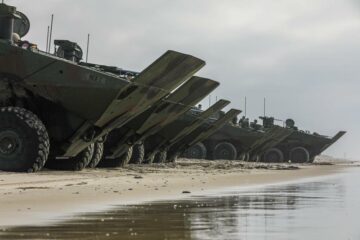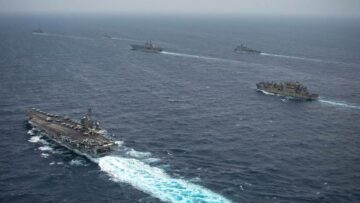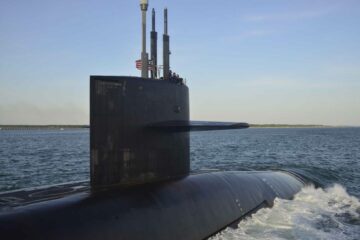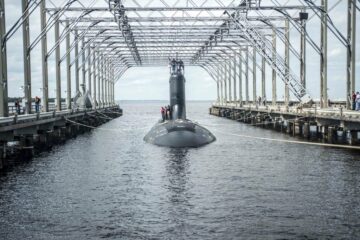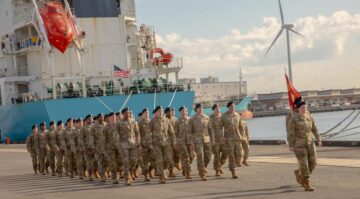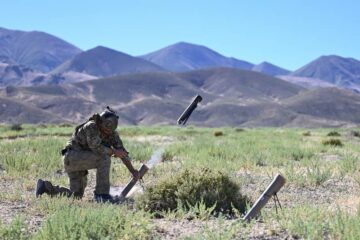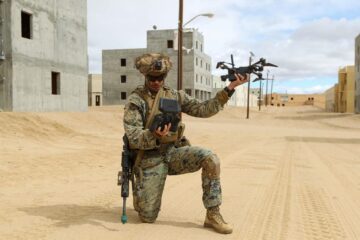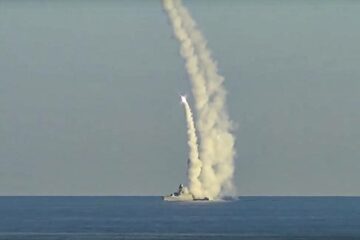The general who has been nominated to become the next top Marine signaled his strong commitment to two of the main priorities of the current commandant: reshaping the Marine Corps and building out the military’s amphibious fleet.
Gen. Eric Smith, who serves as assistant commandant and was a chief architect of the ongoing Force Design 2030 modernization effort, said global threats demand that the Corps not only stay on course with its overhaul but move even faster.
“Force Design is on track — we need to accelerate those areas where we can” through experimentation with the Marine Corps Warfighting Lab, he said during his confirmation hearing before the Senate Armed Services Committee Tuesday.
If given a larger budget, he said, “I’m committed to putting that to things that we are already doing: accelerating being more lethal, accelerating being even more ready … because we don’t know when the fight starts. So we must assume that starts when the sun goes down tonight.”
RELATED
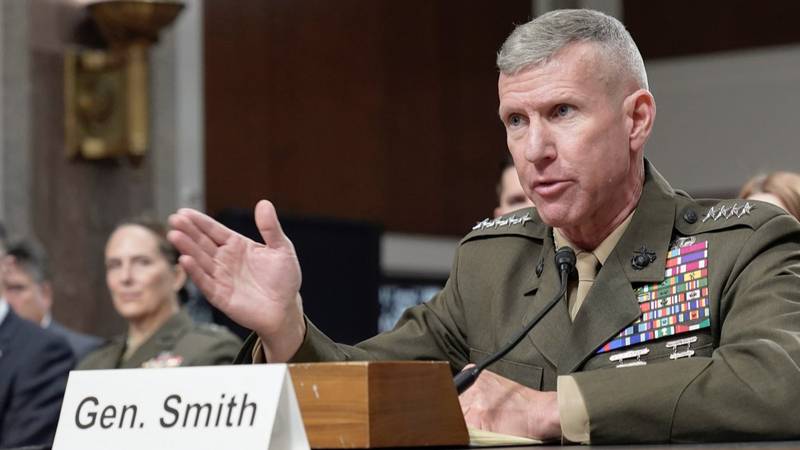
During the Tuesday hearing, Smith faced no questions implying reservations about his fitness for the role of commandant. Instead, senators mostly asked him broad questions about the state of the Corps.
Smith was adamant in his commitment to Force Design 2030, an ambitious restructuring of the service, and to related initiatives focused on training, retention and logistics.
But he expressed a willingness to make course corrections to the restructuring plan as it is currently laid out.
“Any time there’s data that says we need to change to be modern, more lethal or ready, I’m in favor of that, and I’m committed to change wherever change is required,” Smith said.
Force Design has sparked a backlash from a group of retired Marine leaders in the years since the current Marine commandant, Gen. David Berger, announced the plan. Critics have fretted that Marine units of the future — which will be lighter, more dispersed and more focused on amphibious operations — will be less prepared to respond to a range of global crises.
Congress, however, has largely expressed support for Force Design. Smith will need to continue cultivating that support now that, as he acknowledged Tuesday, the Marine Corps can no longer self-fund its modernization efforts through extensive divestments.
“If confirmed, I’ll seek support where required, and I’ll never be shy about telling you what our young Marines need to have an unfair fight in the Pacific or globally,” Smith told senators.
As part of Force Design, the Marines have tried to shed heavy systems or those that require significant manpower or parts to operate forward. They have prioritized systems that can be used by small teams of Marines dispersed throughout the Pacific.
Smith repeatedly talked about logistics as a key focus of his in continuing to implement Force Design. He said the problem requires a range of solutions: deals with allies and partners to pre-stage materiel in forward locations; investing in unmanned systems in all domains to deliver supplies; using new materials to make ammunition and armor lighter and easier to transport; and, especially, investing in additive manufacturing technologies like 3D printing.
“I do see one day we will be printing forward, and forward operating bases will be printing major end items: aircraft engines, propellers,” the general said. “We’ll be doing that forward, as opposed to straining the [supply] lines that come from the United States through contested logistics areas.”
Smith noted the need to buy the intellectual property rights for existing systems and to develop future programs with those data rights in mind. If done correctly, he said, “I can build and print aircraft engines forward,” eliminating entire supply chains that are vulnerable to disruption during a fight.
Smith insisted, as Berger has, that the Marine Corps needs the Navy to maintain a fleet of at least 31 amphibious ships to keep Marines at sea around the globe.
RELATED

“Those 31 amphibious warships, sir, are vital for the Marine Corps and more importantly, sir, for the nation,” Smith said in response to Sen. Dan Sullivan, R-Alaska. “They’re a national asset.”
Smith’s confirmation faces a significant complication: a blanket hold by Sen. Tommy Tuberville, R-Alabama, on senior military nominees. Tuberville is protesting a Pentagon policy that affords troops time off and travel expenses if they seek an out-of-state abortion and has said he won’t let up while the policy is in place.
Smith warned at the confirmation hearing that the hold on nominations could leave key leadership gaps and prevent some lieutenant colonels from getting promoted.
The Marine Corps is the first service scheduled to have a change in top leadership; the Army, Navy and Air Force will also get new chiefs later this summer and fall.
Berger took command of the Corps on July 11, 2019, and must step down after four years, on July 10. If Smith is not confirmed by the Senate by then, he will concurrently be the assistant commandant, the nominee to be the next commandant, and the Marine performing the duties of commandant.
In that acting role, Smith will have all the authorities of a service chief with no limitations, Defense News has reported.
Irene Loewenson is a staff reporter for Marine Corps Times. She joined Military Times as an editorial fellow in August 2022. She is a graduate of Williams College, where she was the editor-in-chief of the student newspaper.
Megan Eckstein is the naval warfare reporter at Defense News. She has covered military news since 2009, with a focus on U.S. Navy and Marine Corps operations, acquisition programs and budgets. She has reported from four geographic fleets and is happiest when she’s filing stories from a ship. Megan is a University of Maryland alumna.
- SEO Powered Content & PR Distribution. Get Amplified Today.
- EVM Finance. Unified Interface for Decentralized Finance. Access Here.
- Quantum Media Group. IR/PR Amplified. Access Here.
- PlatoAiStream. Web3 Data Intelligence. Knowledge Amplified. Access Here.
- Source: https://www.defensenews.com/news/your-marine-corps/2023/06/14/next-commandant-says-he-will-accelerate-marine-corps-transformation/
- :has
- :is
- :not
- :where
- $UP
- 1
- 10
- 11
- 16
- 2019
- 2022
- 2030
- 31
- 3d
- 3D Printing
- 70
- a
- About
- accelerate
- accelerating
- acknowledged
- acquisition
- acting
- additive
- additive manufacturing
- After
- AIR
- Air Force
- aircraft
- All
- already
- also
- ambitious
- ammunition
- an
- and
- announced
- ARE
- areas
- armed
- Army
- around
- AS
- asset
- Assistant
- At
- AUGUST
- Authorities
- away
- BE
- because
- become
- before
- being
- Berger
- broad
- budget
- Budgets
- build
- but
- buy
- by
- CAN
- chains
- change
- chief
- College
- come
- commitment
- committed
- committee
- confirmation
- CONFIRMED
- continue
- continuing
- Corrections
- correctly
- could
- course
- covered
- Critics
- Current
- Currently
- dan
- data
- David
- day
- Deals
- Defense
- deliver
- Demand
- Design
- develop
- dispersed
- Disruption
- do
- doing
- domains
- done
- Dont
- down
- during
- easier
- editor-in-chief
- Editorial
- effort
- efforts
- eliminating
- end
- Engines
- Entire
- especially
- Even
- existing
- expenses
- expressed
- faced
- faces
- Fall
- false
- faster
- favor
- fellow
- fight
- Filing
- First
- fitness
- FLEET
- Focus
- focused
- follow
- For
- Force
- Forward
- four
- from
- future
- gaps
- Gen
- General
- geographic
- get
- getting
- given
- Global
- Globally
- globe
- Goes
- graduate
- Group
- Have
- he
- hearing
- heavy
- him
- his
- hold
- However
- http
- HTTPS
- I’LL
- if
- image
- images
- implement
- in
- initiatives
- instead
- intellectual
- intellectual property
- investing
- IT
- items
- ITS
- joined
- jpg
- July
- Keep
- Key
- Know
- lab
- largely
- larger
- later
- leaders
- Leadership
- least
- Leave
- less
- lighter
- like
- limitations
- lines
- locations
- logistics
- longer
- Main
- maintain
- major
- make
- manufacturing
- Marine
- Maryland
- materials
- May..
- Megan
- Military
- mind
- Modern
- modernization
- more
- mostly
- move
- must
- nation
- National
- Need
- needs
- never
- New
- news
- next
- no
- nominations
- nominees
- noted
- now
- of
- off
- on
- ONE
- ongoing
- only
- operate
- operating
- Operations
- opposed
- or
- our
- out
- Overhaul
- Pacific
- part
- partners
- parts
- pentagon
- performing
- Place
- plan
- plato
- Plato Data Intelligence
- PlatoData
- policy
- prepared
- prevent
- printing
- prioritized
- Problem
- Programs
- Promoted
- property
- Property Rights
- Protesting
- Putting
- Questions
- range
- ready
- related
- REPEATEDLY
- Reported
- reporter
- require
- required
- requires
- Respond
- response
- restructuring
- retention
- rights
- Role
- s
- Said
- says
- scheduled
- Screen
- SEA
- see
- Seek
- Senate
- SENATORS
- senior
- serves
- service
- Services
- she
- shed
- Shifts
- ships
- significant
- since
- Sir
- small
- So
- Solutions
- some
- sparked
- Staff
- starts
- State
- States
- stay
- Step
- Stories
- strong
- Student
- Sullivan
- summer
- Sun
- supply
- Supply chains
- support
- Systems
- taking
- teams
- Technologies
- that
- The
- The Future
- The State
- then
- they
- things
- this
- those
- threats
- Through
- throughout
- time
- times
- to
- took
- top
- track
- Training
- Transformation
- transport
- travel
- tried
- true
- Tuesday
- two
- u.s.
- U.S. Navy
- unfair
- United
- United States
- units
- university
- University of Maryland
- used
- using
- Video
- Videos
- vital
- Vulnerable
- was
- we
- weekly
- What
- when
- which
- while
- WHO
- will
- Williams
- Willingness
- with
- years
- you
- young
- zephyrnet


